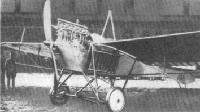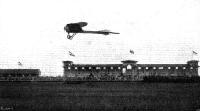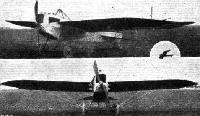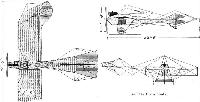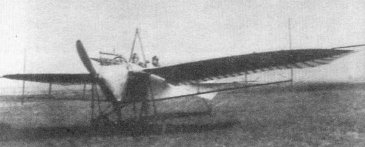
Описание
Страна: Германия
Год: 1913
В.Кондратьев Самолеты первой мировой войны
Двухместный расчалочный моноплан цельнодеревянной конструкции с дополнительным внешним лонжероном под крылом и полотняной обшивкой. Управление по крену гошированием, а по вертикали - отклонением задней кромки стабилизатора. Оригинальный самолет, напоминающий птицу (нем. "Taube" - "голубь") спроектирован в 1910 году австрийским инженером Иго Этрихом. Эта машина стала популярной еще в предвоенные годы, поскольку имела хорошие летные данные и простое управление. Кроме того, она стала и одним из первых боевых самолетов: применялась итальянцами в качестве разведчика и бомбардировщика в войне с Турцией в 1910 г. Самолет выпускался как по лицензии, так и без нее на многих германских и австрийских фирмах, где в конструкцию вносились собственные доработки и изменения, в том числе Румплер, Хальберштадт, Фоккер, Альбатрос, Гота, DFW и Джаннин. В германской военной авиации самолет имел индекс А-1.
Машины разных производителей имели серьезные геометрические и конструктивные различия.
"Таубе" компании "Гота" по конструкции был наиболее близок к оригиналу. Он представлял собой деревянный расчалочный моноплан с фюзеляжем ферменного типа. Самолет не имел ни элеронов, ни рулей высоты: крыло гошировалось, а по вертикали он управлялся отклонением задней кромки стабилизатора. На серийных машинах устанавливался двигатель Мерседес или Аргус.
Аппараты фирмы Хальберштадт имели фюзеляж типа полумонокок и "классическую" схему управления с рулями и элеронами, а самолеты фирм DFW и Джаннин строились с цельнометаллическим силовым набором из стальных труб (так называемые "Штальтаубе").
Компания "Румплер" выпускала несколько вариантов "Таубе", в том числе и на поплавковом шасси. Эти самолеты отличались двигателями, конструкцией шасси, поверхностями управления - первые варианты не имели элеронов и рулей на хвостовом оперении.
За годы серийного выпуска из заводских цехов вышло свыше 500 аэропланов, большинство из которых на счету фирмы Румплер.
В августе 1914 года все самолеты, принадлежавшие частным владельцам на территории Германии, были реквизированы и приписаны к военно-воздушным силам. При этом "Таубе" присвоили индекс А-1. (В немецкой военной классификации буквой "А" обозначали невооруженные монопланы).
В первые месяцы войны "Таубе" наиболее часто применялись для разведки как на западном, так и на восточном фронте. Самолеты этого типа сыграли важную роль в битве на Марне и в отражении русского наступления на Восточную Пруссию. 30 августа 1914 г лейтенант фон Хингессен сбросил с Румплер "Таубе" 3 ручные гранаты и листовки на Париж, совершив тем самым первую в истории воздушную бомбардировку города.
К началу 1915 года аппараты Этриха постепенно уступают место более современным разведчикам бипланной схемы. В учебных частях "Таубе" эксплуатировались еще более двух лет.
ДВИГАТЕЛЬ
"Австро-Даймлер", 120 л.с. (на машинах австрийской постройки) или "Мерседес", 100 л.с. или "Аргус" той же мощности. В отдельных случаях применялись и другие типы рядных моторов водяного охлаждения.
ВООРУЖЕНИЕ
Не предусмотрено.
ЛЕТНО-ТЕХНИЧЕСКИЕ ХАРАКТЕРИСТИКИ
"Гота-Таубе" "Румплер-Таубе"
Размах, м 14,5 13,6
Длина, м 10,0 8,6
Площадь крыла, кв.м 33,4 28,9
Сухой вес, кг 690 600
Взлетный вес, кг 1026 980
Скорость максимальная, км/ч 96 105
Время набора высоты, м/мин 800/12 ?
Потолок, м 3000 ?
Продолжительность полета, ч 4 ?
Описание:
- В.Кондратьев Самолеты первой мировой войны
- O.Thetford, P.Gray German Aircraft of the First World War (Putnam)
- J.Herris Gotha Aircraft of WWI (A Centennial Perspective on Great War Airplanes 6)
- M.Dusing German Aviation Industry in WWI. Volume 1 (A Centennial Perspective on Great War Airplanes 84)
- Журнал Flight
Фотографии
-
J.Herris - Gotha Aircraft of WWI /Centennial Perspective/ (6)
Gotha LE3 A.301/14
-
В.Обухович, А.Никифоров - Самолеты Первой Мировой войны
Гота "Таубе" LE 2
-
J.Herris - Gotha Aircraft of WWI /Centennial Perspective/ (6)
The Gotha LE1 was the first Gotha aircraft; it first flew on 22 April 1913. It was a typical Taube design for the period. Popular in Germany, the Taube configuration was basically obsolete in 1912, before the LE1 was designed. Ten LE1 aircraft were built.
-
M.Dusing - German Aviation Industry in WWI. Volume 1 /Centennial Perspective/ (84)
Lieutenant (ret.) Caspar achieved a German altitude record on Gotha-Taube. (Engine: V8 Aeolus).
Karl Caspar after his high-altitude flight in 1912 (3,245 m) with Gotha-Taube. Engine: Rumpler V8 Aeolus. -
M.Bowden - The Great War's Finest. Volume1: Western Front 1914 /Aeronaut/ (1)
Piloting a Jeannin Stahltaube, Ltn. Karl Caspar became the first pilot to cross the channel and drop bombs on England. (Bundesarchiv, Bild 183-2012-0702-506)
-
Журнал - Flight за 1911 г.
Miss Nellie Beese, the first German lady flyer who has secured her pilot's certificate. This she recently gained on a Rumpler Taube monoplane at the Johannisthal aerodrome, near Berlin.
-
В.Кондратьев - Самолеты первой мировой войны
"Гота-Таубе"
-
J.Herris - Gotha Aircraft of WWI /Centennial Perspective/ (6)
Compared to the LE1, the Gotha LE2 had a redesigned landing gear and a more powerful engine. On 4 November 1914, Lt. Caspar and Oblt. Roos, flying a Gotha LE2, made history when they crossed the English Channel and dropped two bombs on Dover, returning safely after a flight of five and a half hours.
-
В.Обухович, А.Никифоров - Самолеты Первой Мировой войны
Румплер "Таубе" 3С (???)
-
J.Herris - Gotha Aircraft of WWI /Centennial Perspective/ (6)
Gotha LE2 with crew Schlegel and Lt. Spang.
-
J.Herris - Gotha Aircraft of WWI /Centennial Perspective/ (6)
Front view of a Gotha LE2. A limitation of all Tauben was their sluggish wing- and tail-warping controls and automatic stability, which made them inadequate for effectively training pilots to fly comparatively maneuverable biplanes fitted with separate ailerons and elevators. Moreover, their complex rigging required painstaking adjustment and created excessive drag, limiting speed and climb. For these reasons Tauben were quickly superseded by biplanes with conventional controls after the war began.
-
J.Herris - Gotha Aircraft of WWI /Centennial Perspective/ (6)
Rear quarter view of a Gotha LE2.
-
A.Imrie - German Naval Air Service /Arms & Armour/
Basic flying training was initially given at schools run by the aircraft manufacturers. Here, in November 1914, a class of naval ab initio pilots at Gotha Waggonfabrik's aerodrome pose with their Taube. They are wearing 3/4-length coats, trousers and leggings made of leather, which despite lack of lining were all surprisingly warm, being windproof. Gloves, padded crash helmets with goggles and long woollen scarves complete the official issue of flying clothing assigned to the trainee aviators.
-
Журнал - Flight за 1913 г.
PRINCE HENRY PRIZE. - The start at Wiesbaden in front of the grand stands. Lieut. Joly, on the Gothaer mono, is just getting away.
-
J.Herris - Gotha Aircraft of WWI /Centennial Perspective/ (6)
Gotha LE2 after a landing accident.
-
Jane's All The World Aircraft 1919 /Jane's/
Gotha LE "Taube" monoplanes of 1913-14 used for scouting.
-
J.Herris - Gotha Aircraft of WWI /Centennial Perspective/ (6)
The LE3 featured a rectangular fuselage for greater stiffness to prevent twisting in flight. The iron crosses indicate combat service in the war.
The Gotha LE-3, military designation Gotha A I of 1914, was yet another minor variation on the Etrich Taube theme. Gotha built 20 of these two seaters with the army serials A79/14 to A91/14, A119/14 to A125 and A137/14 to A142/14. Employing the 100hp Mercedes D I, range for the machine was quoted as 239 miles. -
J.Herris - Gotha Aircraft of WWI /Centennial Perspective/ (6)
The LE3 also introduced a simplified undercarriage to separate the wing lift wires from the undercarriage structure.
-
J.Herris - Gotha Aircraft of WWI /Centennial Perspective/ (6)
Gotha LE3 A.300/14 parked in a hangar. The rudder of an Albatros B-type obscures the tail of the LE3. In all, Gotha built 111 Taube monoplanes; 89 of those were delivered to the Fliegertruppe.
-
J.Herris - Gotha Aircraft of WWI /Centennial Perspective/ (6)
Gotha LE3 serial A.301/14. Many of the unarmed monoplanes used by the Fliegertruppe, nearly all two-seaters, were Tauben.The military serial and insignia confirm this LE3 is in operational service.
-
J.Herris - Gotha Aircraft of WWI /Centennial Perspective/ (6)
The Gotha LE3 Taube was the LE-type produced in greatest numbers. A robust, well-built machine, it was well suited for operational use and saw service on all fronts. The inherently stable Tauben were actually too stable for air combat and their great drag limited performance. Tauben soon disappeared from the front, replaced by higher-performance biplanes.
-
J.Herris - Gotha Aircraft of WWI /Centennial Perspective/ (6)
The Gotha LE4 after modification and assignment to the Herzog Carl Eduard Fliegerschule in Gotha.
-
J.Herris - Gotha Aircraft of WWI /Centennial Perspective/ (6)
The original configuration of the Gotha LE4. Gotha test pilot Oswald Kahnt, commemorated on this card, was killed when the later LD6 crashed on its maiden flight.
-
Журнал - Flight за 1914 г.
The Gotha Taube.
-
J.Herris - Gotha Aircraft of WWI /Centennial Perspective/ (6)
Rear view of the Gotha LE4; lack of national insignia indicates this is the original configuration before repair.
-
J.Herris - Gotha Aircraft of WWI /Centennial Perspective/ (6)
Side view of the Gotha LE4; lack of national insignia indicates this is the original configuration before repair. The engine was a 100 hp Mercedes D.I inline six-cylinder.
-
J.Herris - Gotha Aircraft of WWI /Centennial Perspective/ (6)
The Gotha LE4 in flight.
-
J.Herris - Gotha Aircraft of WWI /Centennial Perspective/ (6)
The Gotha LE4 photographed after repair and modification. During repair the LE4 was modified to have the front and rear lift wires attached to separate pylons in front and behind the undercarriage. After repair and modification, it was assigned to the Herzog Carl Eduard Fliegerschule in Gotha. The nose radiator and horizontal tail with conventional, hinged elevators made the LE4 much more modern in appearance than earlier Tauben. However, by the time the LE4 was built in 1914, the Taube configuration was obsolete and only a single LE4 was built.
-
J.Herris - Gotha Aircraft of WWI /Centennial Perspective/ (6)
The Gotha logo on a Gotha-built propeller included a Gotha Taube in its design.
-
Журнал - Flight за 1914 г.
16. The Gotha Taube.
-
J.Herris - Gotha Aircraft of WWI /Centennial Perspective/ (6)
Gotha LE3 & LE4
-
В.Кондратьев - Самолеты первой мировой войны
"Гота-Таубе"









